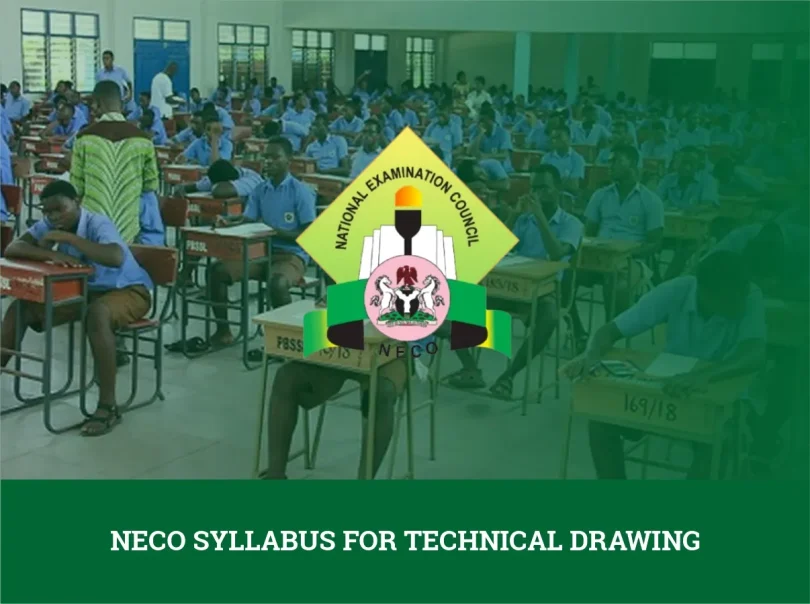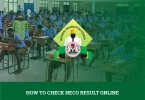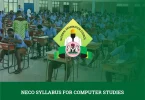Are you preparing for the 2025/2026 NECO Technical Drawing exam? If so, this article is for you as it will guide you through. Technical drawing subject tests students’ understanding of geometric principles, engineering drawings, architectural designs, and others. To excel in the exam, you need to master plane geometry, solid geometry, building drawing, and mechanical drawing, alongside proper use of drafting tools and techniques.
Hence, the reason why the National Examination Council has released the NECO syllabus is to help students focus their study on the topics that matter according to the curriculum and understand the subject before the exams. This guide will break down everything you need to know about the NECO Syllabus for Technical Drawing, from the exam structure, key topics, to the recommended textbooks to help you prepare effectively.
NECO Technical Drawing Exam Structure
The NECO Technical Drawing exam consists of three papers (1, 2 & 3).
Paper 1 (Objective – 40 Marks, 1 Hour)
- Section A (30 Questions): General principles of plane and solid geometry.
- Section B (10 Questions): Candidates choose either Building Drawing or Mechanical Drawing.
Paper 2 (Essay – 60 Marks, 1¾ Hours)
- 5 Questions on plane, solid, and vector geometry (answer any three).
Paper 3 (Practical – 100 Marks, 2¾ Hours)
- Section A (30 Marks, 45 mins): Freehand sketches of tools, symbols, and components (1 compulsory + 1 optional question).
- Section B (70 Marks, 2 Hours): Building Drawing or Mechanical Drawing (choose one).
Detailed Topics in the NECO Syllabus for Technical Drawing and What You Should Learn
Below is a list of the topics in the NECO syllabus that Technical Drawing candidates need to focus on and what they are expected to understand:
1. Plane Geometry
- Drawing materials and equipment (A2 ISO board, set squares, protractor, T-square)
- Lines, lettering, and dimensioning (Types of lines, lettering styles per BS 1192/BS 308A)
- Division of lines (Equal parts/proportional division)
- Scales (Plain/diagonal scales, scale of chords)
- Angles (Types and constructions)
- Triangles, quadrilaterals, and polygons (Regular/irregular shapes)
- Circles (Parts, properties, constructions)
- Tangents and tangency (Applications in tools like spanners)
- Inscribed/circumscribed figures
- Similar figures and areas (Enlargement/reduction)
- Loci (Construction of curves: ellipse, parabola, helix, cycloid, etc.)
2. Solid Geometry
- Lines in space and planes (True length, angle of inclination, traces)
- Pictorial drawing (Isometric, oblique, perspective)
- Orthographic projection (1st/3rd angle, multi-view)
- Auxiliary projections (Prisms, pyramids, cylinders)
- Sectional views and true shapes (Ellipse, parabola, hyperbola sections)
- Development of surfaces (Pyramids, cones, transition pieces)
- Intersection/interpenetration (Of solids like cylinders/cones)
3. Symbols and Conventions
- Standard symbols used in plane/solid geometry
4. Vector Geometry (For Ghana Candidates)
- Forces Co-planar, concurrent, parallel; resultant determination)
- Framed structures (Reactions, internal forces)
- Shearing force and bending moment diagrams
- Centre of gravity (Simple shapes)
5. Building Drawing (BS 1192 Standards)
- Freehand sketching (Building tools in orthographic/pictorial)
- Foundations and floors (Types/parts)
- Openings (Doors, windows, arches)
- Stairs (Parts/types of staircases)
- Roofs (Types/parts)
- Construction details (Walls, beams, columns)
- Working drawings (Orthographic/sectional views)
- Building materials and symbols (Electrical/plumbing fittings)
6. Mechanical Drawing (BS 308A Standards)
- Freehand sketching (Mechanical tools)
- Dimensioning (Tolerances, limits/fits)
- Screw threads and fasteners (Conventional representation)
- Sectioning (Full/half/offset sections)
- Pictorial drawing (Isometric/oblique)
- Working/assembly drawings
- Symbols and conventions (Welding, electrical symbols)
Studying with the NECO syllabus for Technical Drawing will serve as a reference because it structures Technical Drawing topics, exam format, and expectations, helping students focus their preparation effectively. The syllabus also aligns with WAEC standards, making it widely applicable for Nigerian candidates.
List of Recommended Textbooks
- Technical Drawing for School Certificate & G.C.E, by J.N. Green (Spectrum Books)
- Engineering Drawing with Worked Examples 1 & 2 (3rd Ed.) by M.A. Parker & F. Pickup (Nelson Thornes)
- Geometric and Engineering Drawing by K. Morling
- Geometric and Technical Drawing by A. Yarwood (ELBS/Nelson)
- Foundation of Technical Drawing by A. Parkinson
- Technical Drawing with Mechanical Engineering Option by W.E. Kudor
Tips for Success
- Master freehand sketching as it is Critical for Paper 3’s practical section.
- Practice past questions and focus on orthographic projections and loci constructions.
- Use standard conventions following BS 1192 (Building) and BS 308A (Mechanical)
- Ensure complete tools, like the board, T-square, and compass, are functional.
Preparing with the NECO syllabus for Technical Drawing gives you a clear guide and organizes all the topics you need, explains how the exam will be set, and helps you focus your study time wisely. Since it matches WAEC standards, it is useful for most Nigerian students. Make sure to practice sketching and drawing regularly to boost your speed and accuracy, master the basics, and make sure you work with the right tools to avoid mistakes.
Studying past questions helps you get familiar with how NECO/WAEC sets their exams. If a topic confuses you, ask your teacher or classmates and study groups for clarification. Follow or bookmark this site and feel free to visit the comment section if you have any questions!







Leave a Comment